Zenith Defy Inventor: Experimental Compliant Tech Goes Into Serial Watch Production
In late 2017, Zenith and the LVMH research and development department headed up by Guy Sémon introduced new compliant silicon technology in a concept watch called the Zenith Defy Lab. At that time, only ten limited edition watches using the technology had been made.
Almost 18 months following the concept watch’s epic arrival the Zenith Defy Inventor was introduced at Baselworld 2019, which includes the successful implementation of Zenith’s futuristic compliant component.
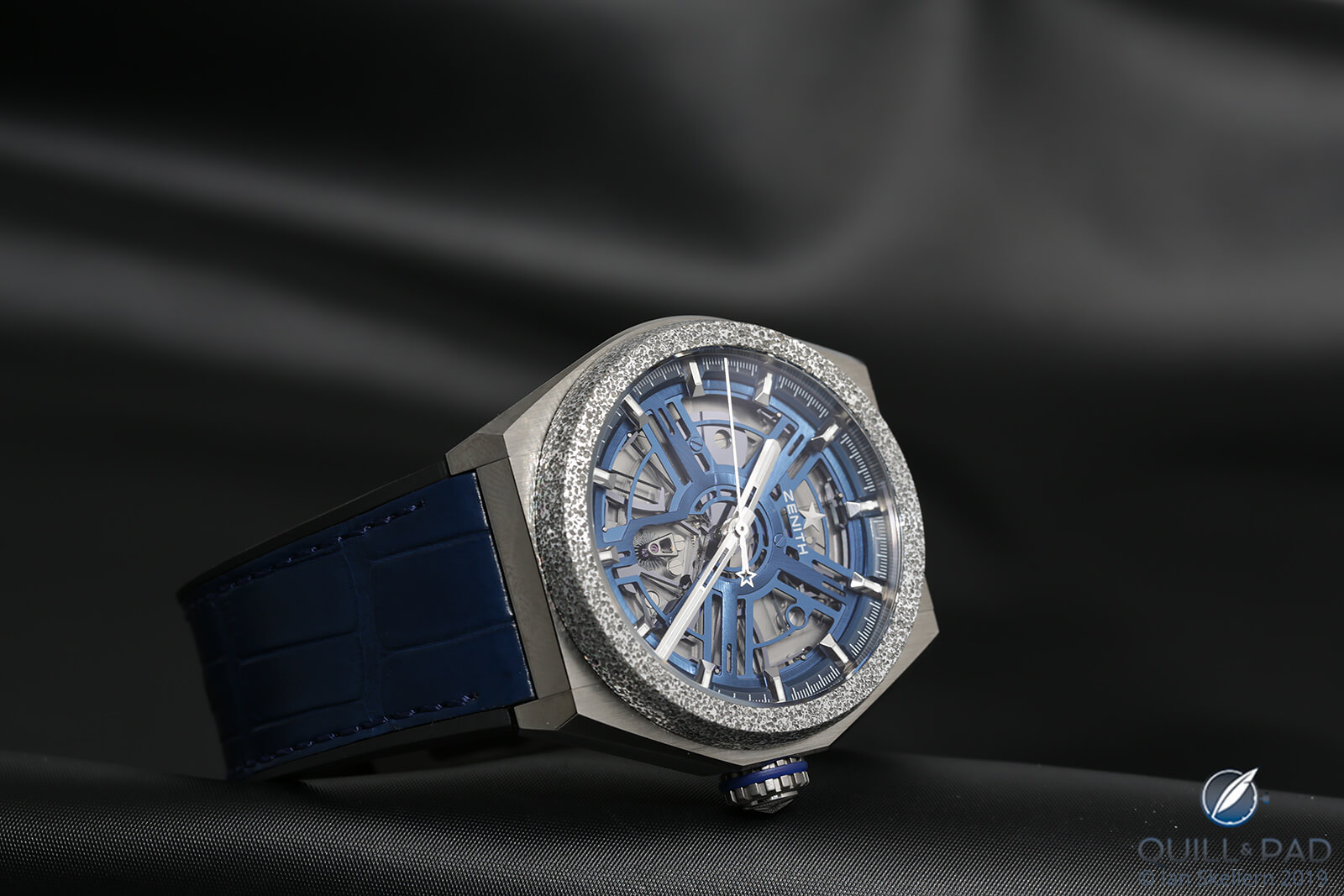
Zenith Defy Inventor
Before we go into the specifics of the serial Defy Inventor, let’s briefly review compliant technology.
What is a compliant mechanism?
The simplest definition of a compliant mechanism is “a component that relies on the elasticity of materials to replace mechanical joints.”
As the compliant mechanism in use in this watch is a single-piece structure – a monolithic silicon whole – that replaces a number of individual traditional components, the need to assemble individual parts is eradicated, simultaneously reducing the energy-robbing friction associated with these parts that is inherent in all mechanical movements. And compliance uses its ability of “deforming” to transfer energy.
These base elements theoretically make it a pretty perfect technology for use in a mechanical movement.
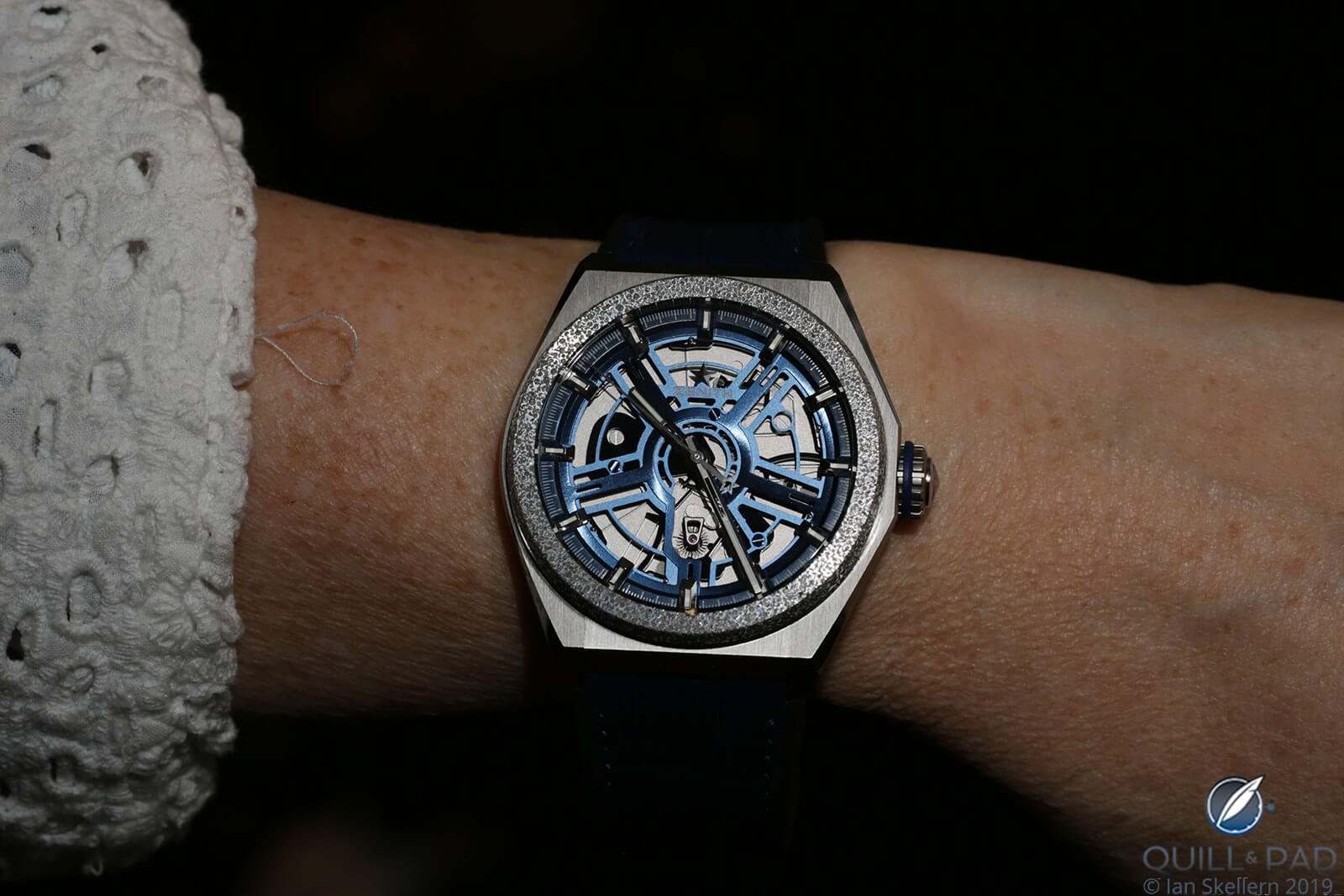
Zenith Defy Inventor on the wrist
Additionally, this single-piece structure replaces what can be called the heart of a mechanical movement: the oscillator, which is the mechanism that sets the timekeeping beat responsible for precision. In total, the silicon compliant piece replaces about 30 parts that would have required assembly, adjustment, setting, testing, and lubrication, including the balance wheel, the balance spring, screws, inertia weights, the pallet lever and pallets, and the regulation assembly as well as a variety of bearing jewels, screws, and pivots.
These are now replaced by one single component only 0.5 mm in height. In contrast, those some 30 components would normally have needed approximately ten times more space (5 mm).
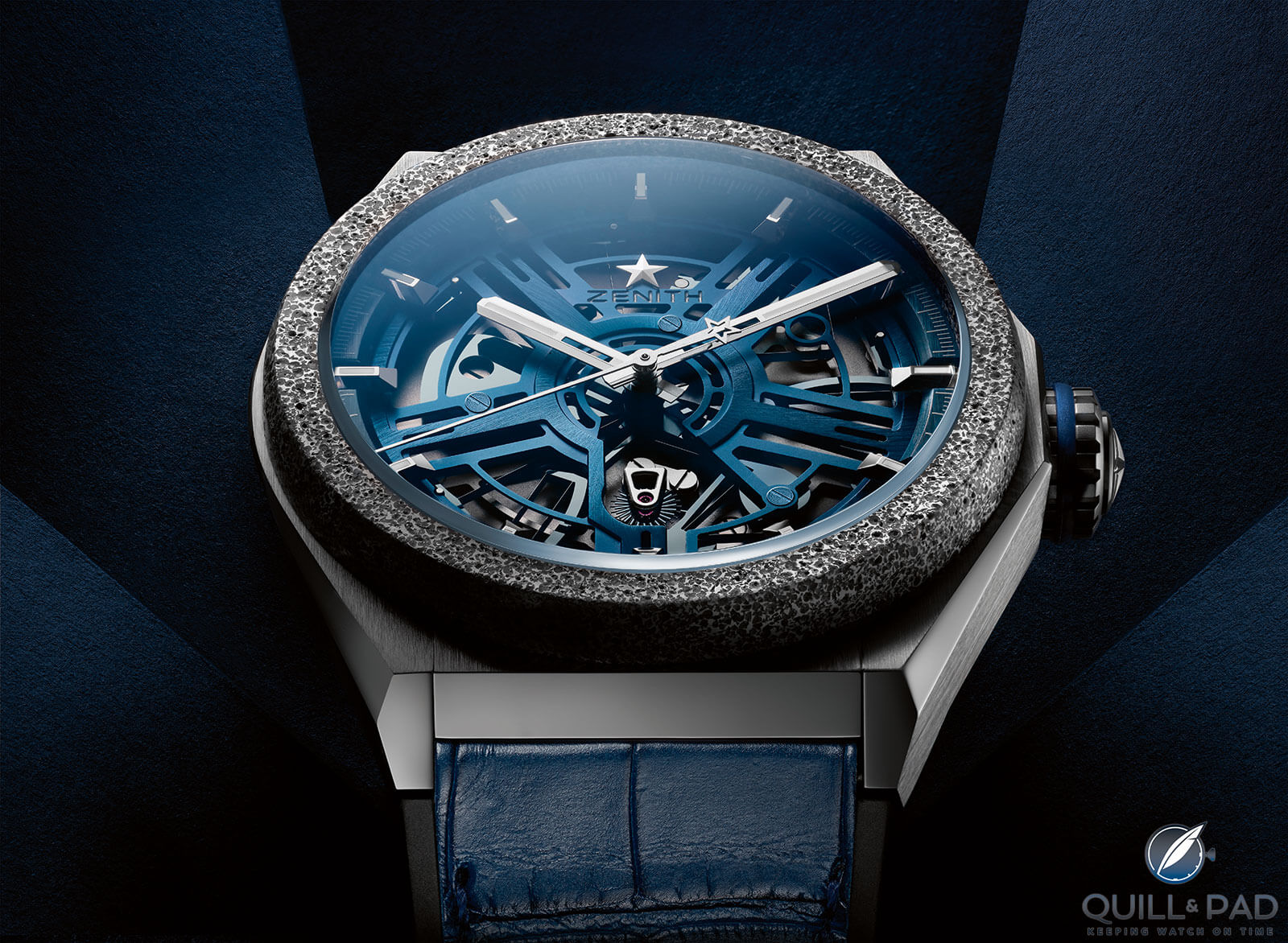
Zenith Defy Inventor
Zenith Caliber ZO 9100: the Defy Inventor’s mechanical pacemaker
Deriving from Zenith’s Defy Lab Caliber ZO 342, the Inventor is powered by Caliber ZO 9100 with a compliant monolithic regulating organ made of silicon coated with a layer of silicon oxide. It beats at the incredibly high frequency of 18 Hz (129,600 vph), more than four times faster than the majority of wristwatches, which beat at 4 Hz or lower.
The primary goal of the Defy Lab’s high frequency is precision – something that usually comes as a tradeoff against wear and tear of components, which compliant mechanisms and silicon components reduce by minimizing the number, size, and mass of components.
The complex compliant mechanism described above has 20 different flexures, the thickest of which is 20 microns. The use of silicon allows insensitivity to temperature, gravity, and magnetic fields as well as no need for lubrication – the bane of the mechanical watch.
Its outside ring (frame) is equivalent to the actual balance wheel, while three “spokes” equal the hairspring and also carry the balance wheel, regulation assembly, and pallets.
Additionally, thanks to its improved energy consumption, the compliant balance is not affected by amplitude (maximum angle of balance oscillation) like a conventional mechanical watch; this oscillator’s amplitude is just +/- 6 degrees. In comparison, a “normal” mechanical system’s amplitude should be between 180 and 315 degrees depending on the type of watch.
The regulation assembly, which Sémon refers to as the “raquetterie,” modifies the stiffness of the spokes using the variable inertia principle. “We adjust the frequency by +/- 300 s/d, equivalent to adjustment of classic hairspring active length,” he explained.
The escape wheel at 6 o’clock, which runs so quickly it is hard for the eye to follow, is not included in the compliant oscillator mechanism. Its functionality, which Sémon told me is based on a Graham escapement principle, is made of silicon “on the same wafer as the silicon oscillator.” It does generate a “tick-tock,” like a classic mechanical watch, but with much less noise due to the faster frequency.
In fact, because of this decreased noise the watch’s rate cannot be measured by a typical Witschi timing machine. So the developmental team had to build a special test bench for it at CSEM, where the silicon components are also manufactured, using laser measurement for timing.
The movement has been officially certified for chronometer precision by TimeLab; for ISO standard 3159 (thermal behavior); and for ISO standard 764 (magnetic resistance). Zenith guarantees at least a 50-hour power reserve.
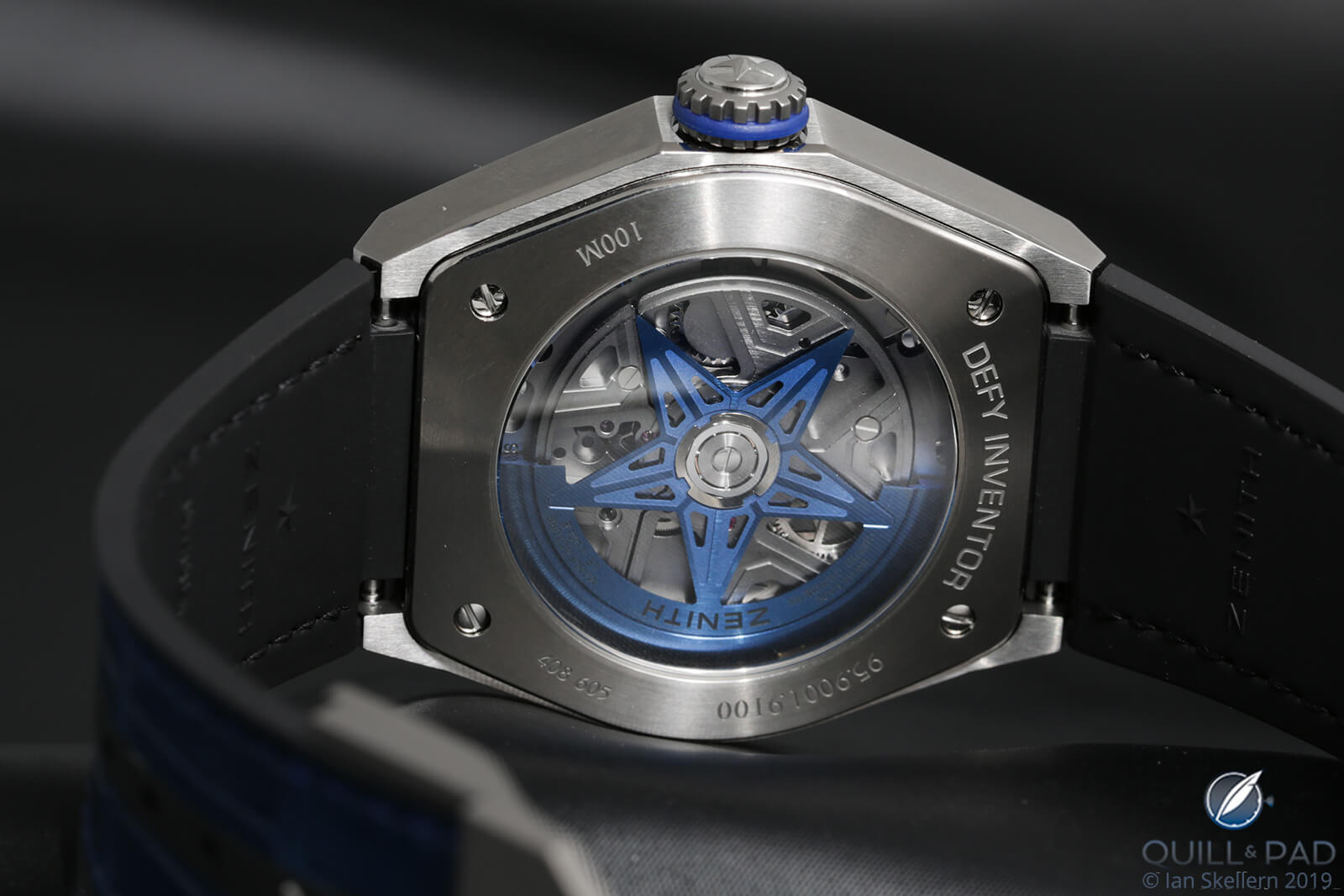
Back of the Zenith Defy Inventor
The Zenith Defy Lab’s Aeronith-pimped case
I maintain that the appearance of this case is very “Hublot” in that it wears its origin as a brainchild of LVMH watch division chairman Jean-Claude Biver and his team on its sleeve. It does have its own charm as a sporty watch, though I do not find it very Zenith-like when you look back through the history of this old brand. The futuristic feel of the case matches the purpose of this watch in showcasing the new technology, though.
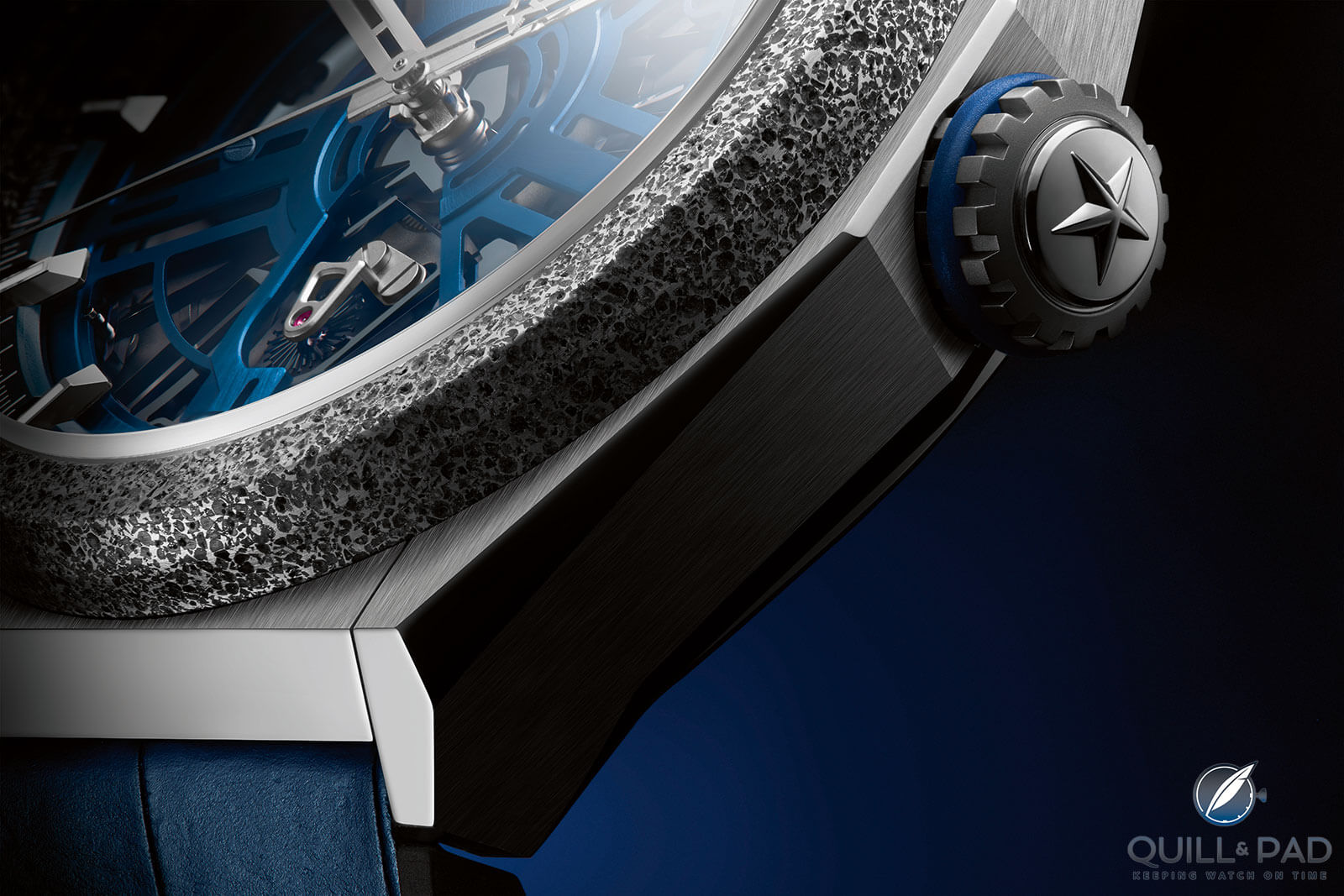
Titanium case and Aeronith bezel detail of the Zenith Defy Inventor
The bulky case, 44 mm in diameter and a sleeve-splitting 14.5 mm in height, is crafted in brushed titanium, while the bezel – which steals the spotlight – is made of LVMH’s patented Aeronith, the lightest aluminum composite in the world.
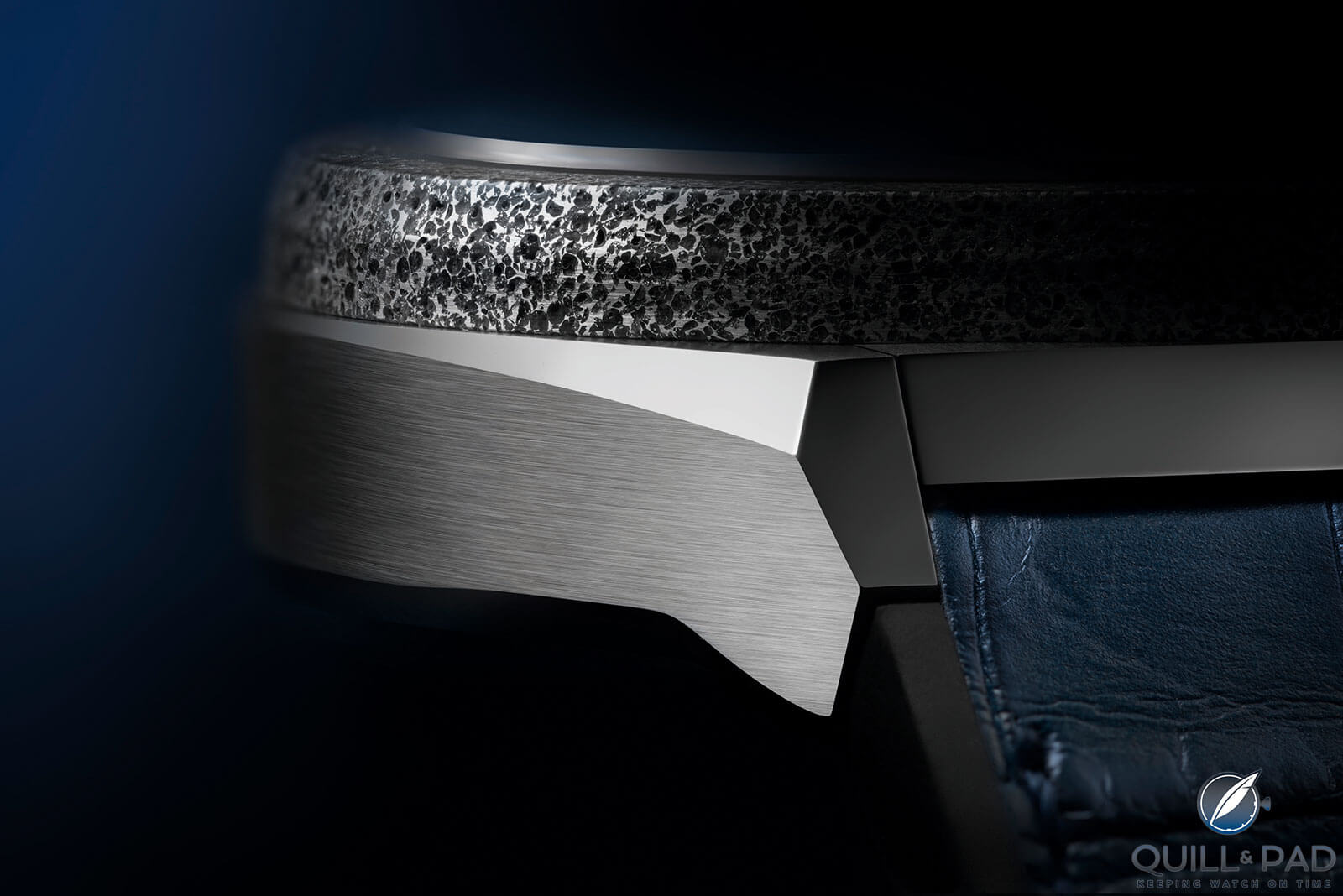
Angular titanium lug underneath the Aeronith bezel of the Zenith Defy Inventor
Almost three times lighter than titanium and 10 percent lighter than carbon fiber, Aeronith is made of an open-pore aluminum foam stiffened with a polymer using a high-tech process involving heating 6082 grade aluminum to its melting point and pouring it into a mold. Zenith claims the machining is as easy as that of traditional precious metals.
The openworked dial allows a full view of the compliant mechanism pumping away at its ultra-high frequency inside. The contrasting blue of the dial forms an attractive color combination that highlights the dial framework. The main dial element has five-spokes evoking a stylized propeller; the five blades symbolize the Zenith star according to the brand.
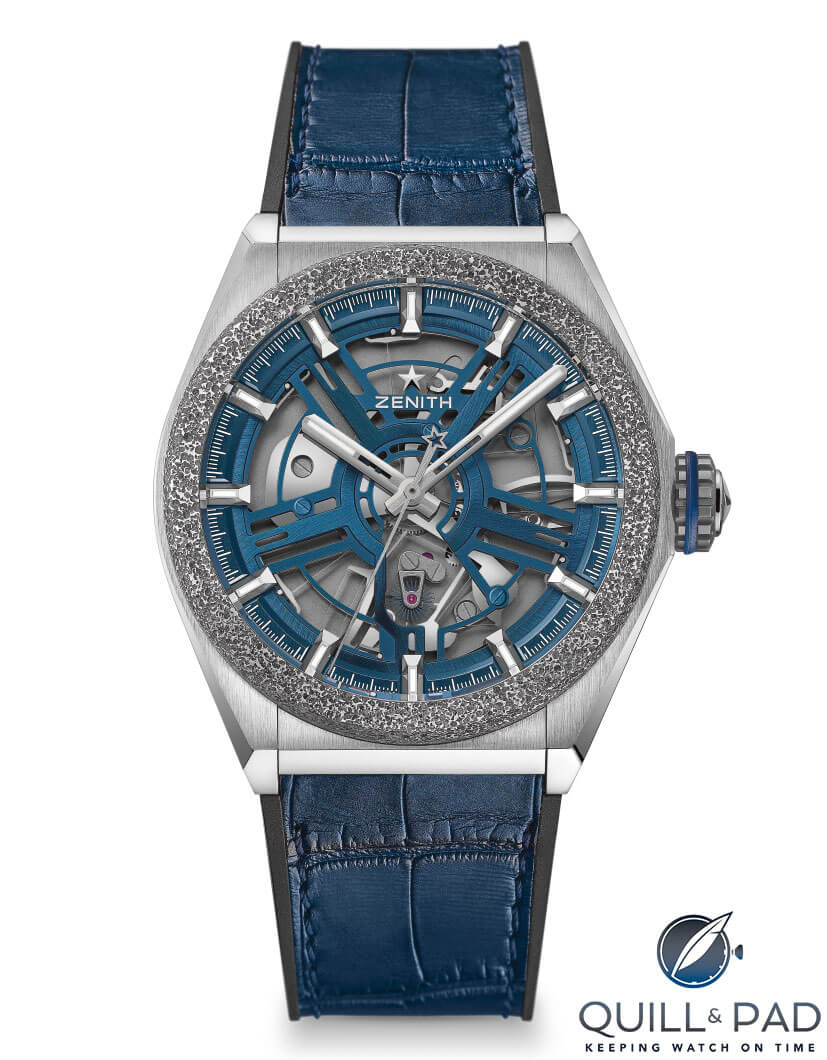
Zenith Defy Inventor
Will the Defy Inventor’s latest technology change how mechanical watches are viewed and possibly change how they are made? That remains to be seen, but we will soon know what the public thinks. Let us know if you are for or against, or think it’s too early to tell, in the comments below.
For more information, please visit www.zenith-watches.com/campaign/defy-lab.
Quick Facts Zenith Defy Inventor
Case: 44 x 14.5 mm, titanium with Aeronith bezel
Movement: automatic Zenith Caliber ZO 9100 with monolithic silicon oscillator; 32.8 mm diameter; 148 components including 18 jewels; 18 Hz/129,600 vph frequency, power reserve 50 hours
Functions: hours, minutes, hacking seconds
Price: 18,900 Swiss francs
You may also enjoy:
The Zenith Defy Lab Highlights Technology That Could Change Future Watchmaking
Zenith Defy Zero G: A Lesson In Miniaturization
Exceptional Movements In History: Zenith El Primero
Give Me Five! All 5 Of Patek Philippe’s Advanced Research Limited Editions
Leave a Reply
Want to join the discussion?Feel free to contribute!



i nominate the author of this piece as the best writer on technical subject matter of mechanical watches. After following the major watch blogs for nearly a decade, there are other good writers in this area–eg, Jack Forrester at Hodinkee is regularly praised in the chatty comment sections underneath his articles. And indeed, JF’s very good, and clearly the flashier prose stylist. Still, i’ve read enough articles from both on the same subjects to know that nearly always it’s Ms Doerr whose articles are best infused with not-obvious historical precedent (see above article, “compliant mechanism”, a crucial element to the story of Defy Lab, though not mentioned in any of JF’s pieces on this subject), and mind-numbing technical minutiae nearly always explained in astonishingly simple language (that even i can grasp).
Wow, thank you! That is quite a compliment. I do try to explain the tech to the best of my ability and I’m very glad it seems to be working as intended! Thank you for reading!
Thank you very much for this article.
I am puzzled why there has been a relative lack of online news discussion about this watch during Baselworld, particularly given its progressive approach to chronometry. I recognise that the technology was talked about when the Defy Lab was announced, but I think that this mainstream release coupled with an aggressive pricepoint is worth highlighting. I’m sure Ulysse Nardine will not be pricing its Freak Next (which to my limited understanding seems to be based on a similar escapement) at anywhere near this level.
Where current watches try to address accuracy with technologies that are hundreds of years old, I think we should we make more of those which use modern technologies to keep the mechanical watch relevant.
Hi and thanks for your comments and questions! You’re right that there has been a lack of discussion on this piece, and I can only explain it with the fact that Baselworld has just ended and everyone is still digesting the deluge of new watches. Perhaps Zenith would have been better off bringing it out at a different time to get more buzz going (like the Defy Lab), but that is probably the reason it hasn’t been singled out. And with sister brand TAG Heuer having released its Autavia with Isograph spring at Baselworld as well, there are two big tech things to be talking about. So attention is divided.
Truthfully I cannot comment on the Freak Next because I have not seen it myself yet. Though looking over the materials, I’m not sure it’s similar. However, I’ll reserve official judgement for when I get to talk to someone about it and see for myself.
New technologies are something I have been following closely since day one, and the varieties of them now coming out are exciting. It will be exciting to see which of them ends up being the one the industry sticks with in the end. Maybe even one we haven’t seen yet?